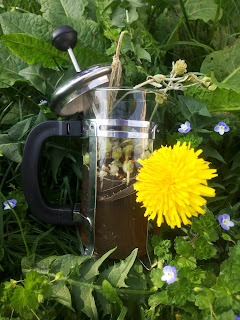Welcome spring! April, fairy dust!
During this month, we
talk about “Sweet April showers, do
spring May flowers”, “April comes in with his hack and his bill, and sets a
flower on every hill”, “Tis worth more than oxen and wain” act. The buds
hatch slowly in the first rays of the sun, without any forcing, therefore the
rains and short thunderstorms can be a help especially for the harvest “April cold and wet fills barn and barrel”,
“Betwixt April and May if there be rain”, or worse if it is too much !!
In this period there
is the awakening of the muscles and
thus also the hormonal one! For some
people this change is automatic
without major adaptations instead for
some it is a stress going
towards a strong sense of tiredness
(astenos in Greek means lack of strength), insomnia
etc.
For this reason, I thought
of some plants that are common in
the mountains during this period,
therefore watercress, hops and lemon balm.
Enjoy your reading and I await your comments! See you soon!
The
cress (Lepidium sativum)
is an annual plant (a vegetable) of
the Brassicaceae family (such as cabbage, cauliflower).
It is preferred in the kitchen due to its acidic and spicy flavor and sometimes even
as a spice one. The leaves are used fresh as one time dried
they lose their properties. It has been cultivated since ancient times,
appreciated by the Persians (they
believed it helped the growth of children) and by the Romans as a promising aphrodisiac.
It arises spontaneously along streams and still waters. There
are three different types of watercress:
water (bitter taste), vegetable garden, lawns (slightly spicy flavor). It has a
low calorie content (32 kcal per 100 gr of fresh plant). Contains water, carbohydrates, proteins, fiber, fats, and very
important mineral salts such as K +, Ca2 +, P3- / 5 +, Mg2 +, Na +, Fe4 + and
let's not forget the vitamins especially A, C (which facilitates the
absorption of Fe, therefore a powerful anti-anemic), K (bone well-being), E,
folate (suitable in pregnancy to prevent certain fetal malformations) and
those of group B (against fatigue).
Its phyto-complex contains even antioxidants such as beta-carotene,
glucosinolates (in particular gluconasturtiin which together with Zn is a
powerful antiseptic therefore affections of the respiratory system, bronchitis,
phlegm in the bronchi, eczema, pulmonary emphysema, gout, fever , wounds, flu,
colds, firm and strengthen weak gums), lutein
and zeaxanthin (counteract oxidative stress), isothiocyanates (powerful antitumors especially for the prevention
of breast cancer). This phyto-complex also makes it suitable as a hypo-cholesterol-lowering agent.
Finally, it is an appetite and digestive
stimulant for the presence of bitter substances. You can use it in DIY masks as a nutrient for dry skin and in
case of hair loss.
There are contraindications related to excessive consumption in case of
gastrointestinal gastritis and ulcers; urinary tract inflammation; kidney
disease.
There are various
forms but I recommend the macerate by
macerating in a liter of cold water 100 g of fresh and well-washed plant, after
12-14 hours (about a whole night) pour and drink 3-4 glasses of macerate
sweetened with honey during the course of the day.
The
wild hops are similar to wild asparagus; in fact,
they blend very easily! They are mainly harvest in April until May and have excellent purifying, laxative, toning,
refreshing and diuretic properties. They are low in calories !! It contains bitter
principles, essential oils, tannins and flavonoids therefore it must be used as a mild sleeping pill, sedative in
case of agitation for both adults and children, gastric nervous disorders,
antibacterial activities, estrogenic activities.
A herbal tea is prepared by letting infuse
0.5 g of dry cones (almost 1 coffee spoon) in boiling water for 10-15 minutes.
It is recommend to drink 2-3 cups a day,
as a calming agent and to double the dose for a sleepy action. The "local" folk Venetian medicine
advise to put the dry cones in a bag inside the pillow so the volatile
essential oils would induce sleep! It is also considered blood antioxidant and stimulant of liver functions as well as the
imperfections of cellulite.
Lemon
balm is a perennial herb
plant native to Southern Europe and Asia, of which leaves and flowers are
useful for healing purposes. This
plant (which is also my favorite) acts at different levels therefore
sedative: it acts on the central nervous
system therefore useful on anxious
and anxious-depressive syndromes and sleep disturbances of nervous origin,
as well as on various manifestations of nervous origin such as palpitations, extrasystoles, tachycardia,
dizziness, stress tinnitus, migraines of nervous origin and also the cough;
Antispasmodics on the gastrointestinal and
genitourinary tract: soothes gastrointestinal disorders such
as dyspepsia, aerophagia, flatulence,
nausea, vomiting, gastritis, peptic ulcer, gastrointestinal spasms, and
menstrual pain;
Antiviral, antibacterial and antifungal: it is able - for example - to treat herpes simplex type 1 labial
infections and is a powerful antifungal;
Healing and astringent (if applied locally).
The side effects of
Melissa officinalis can be contact
allergy (cutaneous) with itching similar to urticaria. It is not
recommended to use it for people with hypothyroid-like
diseases even in cases where eutirox is taken because it acts by partially
inhibiting the activity of the thyroid gland and consequently also by pregnant
and lactating women. It can also increase
intraocular pressure therefore, it is also not recommended for those with
or at risk of developing glaucoma.
The herbal tea is prepared in the form of an
infusion using 1 teaspoon of dried lemon balm leaves for each 250 ml cup of hot
water, leaving to infuse for 5 minutes and then filtered. They should be drunk
1-2 cups a day according to the need.



Commenti
Posta un commento